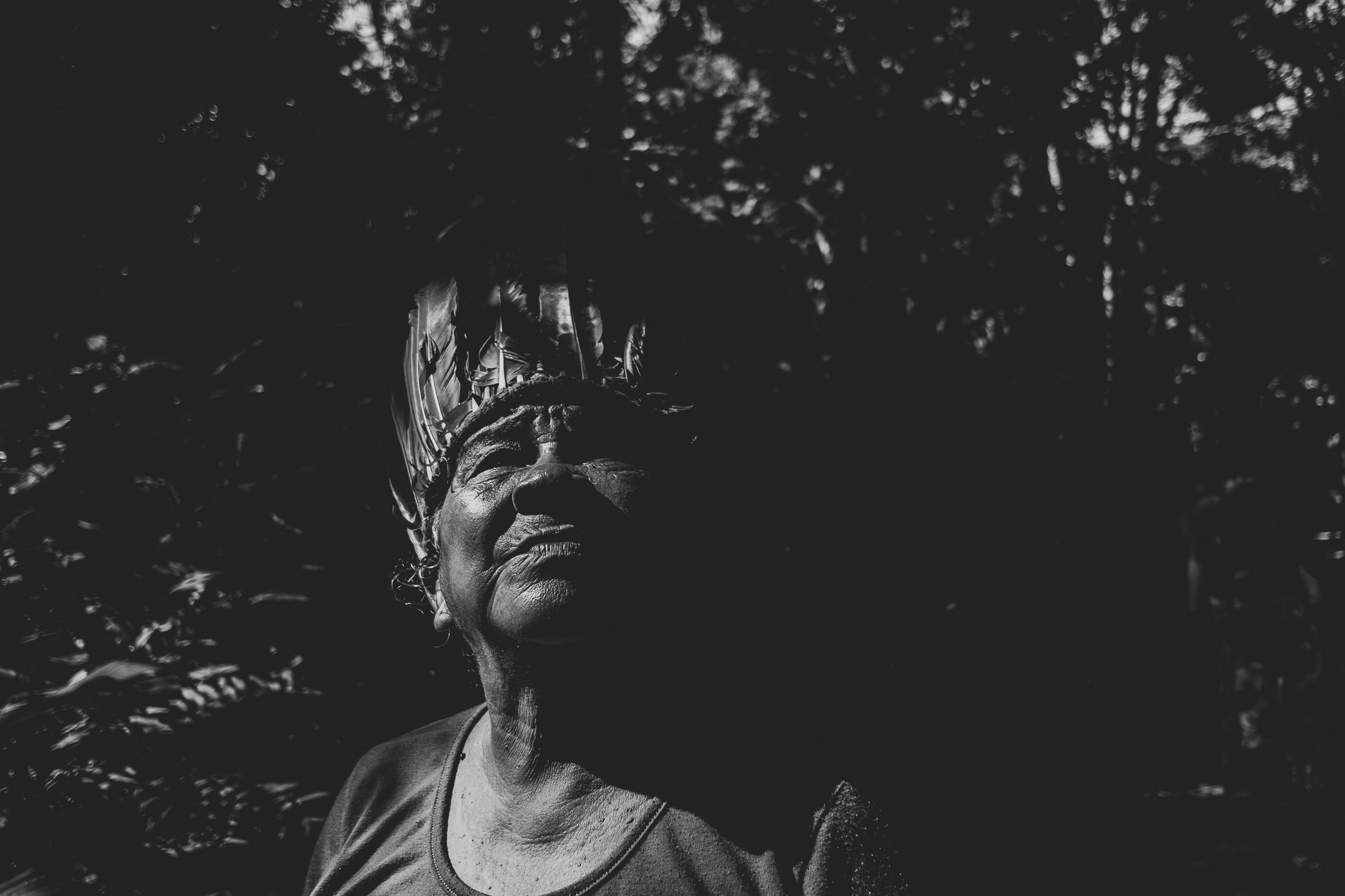THE DEATH OF THE TUPINAMBÁ AND THE CHANT
Pajé Luiza Tupinambá, Aldeia Marabaixo, Resex Tapajós-Arapiuns (PA)
Wistful longing in the Marabaixo village
THE DEATH
What falls silent when a Shaman dies? More than a spiritual leader, for many indigenous villages/communities in Brazil, the Pajé (Shaman) is synonymous with the only opportunity to cure physical and spiritual illnesses. The disappearance of this entity can cause overwhelming imbalance, as well as emptiness, silence, death. This is the feeling surrounding the Marabaixo village, of the Tupinambá people, located in a small cove in the Tapajós-Arapiuns Extractive Reserve in the west of Pará state, which still mourns Shaman Luíza Tupinambá.

In March 2020, Marabaixo, with just over 50 families, witnessed the village’s elder woman and shaman die of COVID, without any possibility of health care access. Luíza Tupinambá, 83, was an important leader for her people. Today the country finds itself in the sad figure of more than 500,000 dead and 1,071 Indigenous people killed by COVID-19, according to the Association of Indigenous Peoples of Brazil (APIB).
A victim of the current administration’s lack of health care, Luíza died at her home, soon after returning from Santarém, the closest city to the village, with all the symptoms of the disease that was unknown at that moment. She went to the city once a month to access the social service aid she received.

Cacique (Chief) Genildo laments the void left by the death of Shaman Luíza.

“She felt the symptoms, and no team had come to test the communities and villages. We heard on the radio what were the symptoms of COVID, and we suspected that it could be COVID,” explains Genildo Tupinambá, Chief of Marabaixo village..”

VOID
In the space of a week, Luíza died without receiving any basic medical care. According to Chief Genildo, when the Shaman began to show the first symptoms, hospital beds were occupied in Santarém, and she decided to use all her knowledge to cure herself at home. Luíza made a natural medication based on a native plant, Kumaru, she taught her family to prepare it, but shortly after fell victim to the virus. In the same week of her death, the entire community was contaminated. By an irony of fate, to this day, the Shaman was the only who died in her village.

“Everyone here was shaken, everyone fell (were contaminated), and it was a difficult situation for us to face this disease, mostly in terms of aid. That’s when the medicinal herbs that our shamans taught us came in, precisely our shaman Luíza, who was a victim, taught us to use the medication,” says the Cacique about the use of traditional medicine to help treat COVID- 19.

Relatives visit the house left by Shaman Luísa. Her belongings have been distributed among family members
THE DELIVERY
Before she died, Shaman Luíza called another shaman from Marabaixo, her namesake and healing companion, Shaman Iza, passing on her feather headdress, which she always wore in her healing rituals, and the maracá, an instrument that she played for her “enchanted ones,” healing spirits for the Tupinambás.
A week after handing over the symbols, Luíza was buried in her village, where she was born and lived. She is gone, but her presence still remains in the community, in the memories, in the chants, and in the acts of blessing and healing. Already vaccinated, Shaman Iza took over from the deceased shaman, but still deeply misses her partner.
The village’s history is linked to the music and songs that the enchanted spirits used to perform in a nearby cove. The late Shaman Luíza was the only resident in the community who knew the chants of the enchanted ones, and beat on a small drum. She taught some of these chants to her village—others were silenced with her. The small excerpts of the songs that remained populate the community, and the memory of the struggle encouraged by Shaman Luíza became a perpetual chant for Marabaixo. A chant that pulsates from within.

The headdress left by Luíza for her friend and substitute, Shaman Iza.

“She said to me: ‘Sis, I’ve already been there with this headdress and this xeque xeque (maracá), and I’m going to give them to you.’ I said: ‘Why already, Luíza?’ Then she said: ‘I’m passing them on to you.’ It was the week that we traveled to Santarém.” Shaman Iza tells about the last conversation they had before both were contaminated by COVID-19.


Luíza’s xeque xeque

Luíza used the walls of her house as a notepad
THE CHANT
The Marabaixo village is not formally recognized by the demarcation process of the National Indian Foundation. But, contrary to the speeches given by Jair Bolsonaro that he “will not demarcate one single square centimeter” in Brazil during his administration, Marabaixo, together with the 21 Tupinambá villages in the Lower Tapajós, is actively participating in the process of self-demarcation of their territory, which they call “Nação Tupinambá” [Tupinambá Nation]. Since 2017 the Tupinambás have been autonomously organizing to demarcate the full extension of their territory, which comprise 350,000 hectares. Shaman Luíza actively participated in the self-demarcation movement.
Shaman Iza sings along the trails of Marabaixo, in homage to Luíza.

“What she left for us was the memories, cultures, teachings and encouragement. Just as she used it, she also taught us how we should do it, what the path was,” says Shaman Iza with nostalgia.

Marabaixo, the rhythm that lends the village its name
The village’s history is linked to the music and songs that the enchanted spirits used to perform in a nearby cove. The late Shaman Luíza was the only resident in the community who knew the chants of the enchanted ones, and beat on a small drum. She taught some of these chants to her village—others were silenced with her. The small excerpts of the songs that remained populate the community, and the memory of the struggle encouraged by Shaman Luíza became a perpetual chant for Marabaixo. A chant that pulsates from within.
Galeria





Reportagem especial: Mídia Ninja e Amazon Watch
Reportagem: Tainá Aragão
Fotos: Leonardo Milano
Vídeos: Priscilla Tapajoara
Edição de Vídeo: Benjamin Mast
Design: Yasmim Moura, Aruan Mattos
Diagramação e montagem: Kelly Mariah Batista












